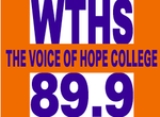
WTHS
Encyclopedia
WTHS-FM 89.9 is a student operated radio station
licensed to Hope College
in Holland, Michigan
.
communities, including some on-campus rooms. WTAS was the only station carried in mono. The Holland Community channel carried by Continental Cablevision on channel 12, which scrolled public service events on the screen, also carried WTAS as its audio signal.
Celebrating 50 years of broadcasting, WTHS relocated into the newly constructed Martha Miller Global Center for Communication, with the official dedication held on Wednesday, January 24, 2007. These facilities feature "state-of-the-art" professional equipment, with DAD (digital audio delivery) software by ENCO of Southfield, Michigan, used by some of the leading stations and networks in radio and television.
WTHS continues to thrive as an alternative rock station, operating 24 hours, 365 days a year. The station is simulcast on the internet, but access is only allowed to those with a valid Hope College ID.
Radio station
Radio broadcasting is a one-way wireless transmission over radio waves intended to reach a wide audience. Stations can be linked in radio networks to broadcast a common radio format, either in broadcast syndication or simulcast or both...
licensed to Hope College
Hope College
Hope College is a medium-sized , private, residential liberal arts college located in downtown Holland, Michigan, a few miles from Lake Michigan. It was opened in 1851 as the Pioneer School by Dutch immigrants four years after the community was first settled...
in Holland, Michigan
Holland, Michigan
Holland is a city in the western region of the Lower Peninsula of the U.S. state of Michigan. It is situated near the eastern shore of Lake Michigan on Lake Macatawa, which is fed by the Macatawa River ....
.
Carrier Current
The station began as WTAS in 1956, when students Richard Brockmeier and Jack Hellriegel transmitted a signal from their room through the wiring of the then-new Kollen Hall (residence dormitory) on the Hope College campus. Brockmeier joined Hope's faculty in 1966, teaching computer science and physics until his death in 1993.WTAS-AM 610
Regular programming began in 1957. WTAS originally meant "We're The Arkie Station", paying homage to the Arcadian Fraternity, to which Brockmeier and Hellriegel belonged. The staff reconsidered its campus-wide influence and WTAS officially became "THE ANCHOR STATION", re-named for the Anchor, Hope's symbol and a reference to the Holy Trinity. As reported in the April 26, 1957 issue of the student newspaper The Anchor, they had "realized the need of a new radio station to solve a problem which had arisen at the dorm. Due to modern construction methods of using reinforced steel and concrete, almost all outside signals are cut off from radios." For over 25 years, the station operated from studios in the basement at the southwest corner of Kollen Hall. In 1981, WTAS began simulcasting at 103.3 FM, on a radio service then offered by local Continental Cablevision of Holland (now Comcast). This "FM cable" carried a number of Chicago and West Michigan FM stations. It was offered to cable television subscribers throughout the Holland and ZeelandZeeland
Zeeland , also called Zealand in English, is the westernmost province of the Netherlands. The province, located in the south-west of the country, consists of a number of islands and a strip bordering Belgium. Its capital is Middelburg. With a population of about 380,000, its area is about...
communities, including some on-campus rooms. WTAS was the only station carried in mono. The Holland Community channel carried by Continental Cablevision on channel 12, which scrolled public service events on the screen, also carried WTAS as its audio signal.
WTHS-FM 89.9
A student project to replace the aging AM carrier current station was started in the fall of 1979 by freshman Richard Kennedy. Tentative approval to move forward on this proposal was passed by the Hope College Student Congress on Monday, November 24, 1980. Under the advice of WZZM-TV 13 (Grand Rapids, Michigan) Chief Engineer Dale Wolters (his father, Dr. Edward J. Wolters, taught Classics at Hope College for 40 years, retiring in 1966), E. Harold Munn and Associates of Coldwater, Michigan was retained to do a feasibility engineering study. The application to the Federal Communications Commission was tied up when a newly-founded Zeeland-based church attempted to secure the license for 89.9, thus delaying the actual official sign-on date until Friday, September 27, 1985. The call signs WLQX ("The Lakeshore's Alternative") and WMCH("West Michigan's Alternative") were proposed, but later it was decided to apply for WTHS, as it was closer to the original WTAS call letters. WTAS-FM belonged to a station in Crete (Chicago), Illinois at that time, thus was unavailable. WTHS-FM 89.9 ("We're The Hope Station") was licensed to operate with 1,000 watts (directional) at 199 feet (154 feet above average terrain). New studios in the DeWitt Center were built adjacent to the theater.Celebrating 50 years of broadcasting, WTHS relocated into the newly constructed Martha Miller Global Center for Communication, with the official dedication held on Wednesday, January 24, 2007. These facilities feature "state-of-the-art" professional equipment, with DAD (digital audio delivery) software by ENCO of Southfield, Michigan, used by some of the leading stations and networks in radio and television.
WTHS continues to thrive as an alternative rock station, operating 24 hours, 365 days a year. The station is simulcast on the internet, but access is only allowed to those with a valid Hope College ID.

